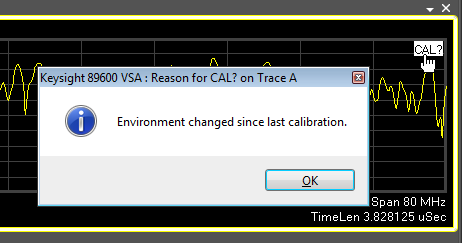Trace Indicator Messages
Trace indicators, displayed in the upper right corner of the trace grid, provide information about the currently-displayed trace data. If you click on the Trace Indicator, the VSA displays a brief description of the condition that caused the error.

Only one trace indicator can appear at a time. Therefore, the VSA uses the following priority to determine which trace indicator to show when more than one exists:
|
Highest Priority |
|
|
. |
|
|
. |
|
|
. |
|
|
. |
|
|
. |
|
|
. |
|
|
. |
|
|
. |
|
|
Lowest Priority |
For details, click on the names of any of the indicators listed below:
|
|
|
Message |
Explanation |
|---|---|
|
|
Trace indicator. Show All Frequency Points is enabled. |
|
CAL? means the data contained in the trace is uncorrected or not fully corrected for one of several reasons. CAL? appears if calibration data is missing because the hardware configurations have changed and have not yet been calibrated. It also appears if the hardware's environment (e.g. temperature) has changed sufficiently to invalidate the previous calibration. In either case, perform a Single Cal. Another cause for CAL? is the absence of factory calibration files for the 89605 or E2730 modules. CAL? also appears if the User Calibration file was not created properly. The CAL? indicator does not indicate the current state of the hardware, but rather the calibration status when the data was acquired. This means that traces that are saved with the CAL? indicator will also show the CAL? indicator when recalled. |
|
|
Trace indicator that may appear when using Digital Demodulation to demodulate VSB signals. It informs you that the demodulator is unable to lock to your signal. For further details, see Setting up a Digital Demodulation Measurement. This message is also displayed for W-CDMA Code Division Multiple Access: One of several digital wireless transmission methods in which signals are encoded using a specific pseudo-random sequence, or code, to define a communication channel. A receiver, knowing the code, can use it to decode the received signal in the presence of other signals in the channel. This is one of several "spread spectrum" techniques, which allows multiple users to share the same radio frequency spectrum by assigning each active user an unique code. CDMA offers improved spectral efficiency over analog transmission in that it allows for greater frequency reuse. Other characteristics of CDMA systems reduce dropped calls, increase battery life and offer more secure transmission. See also IS-95. and cdma2000 measurements when the demodulator is unable to lock to the signal.
|
|
|
"Data is questionable relative to the current setup." This can happen if a measurement is paused and, for instance, you change the span. If a measurement is paused, changing most measurement parameters (those under the MeasSetup menu) result in questionable data (DATA?). For more information about what caused the data to be questionable, click on DATA?, and the VSA will provide an explanation. |
|
|
The Digital Demodulation equalizer is on. |
|
|
With channel data in W-CDMA or cdma2000 displayed, the currently selected channel is not active. |
|
|
For W-CDMA or csma2000 measurements, most results use the measurement offset and measurement interval parameters. A few results do not, and instead use the first slot (PCG) of the data. For these results, "MEAS OFFSET?" is displayed if the measurement offset parameter is non-zero or the measurement interval parameter is greater than one. This is a reminder that these results don't use the current measurement offset or measurement interval. |
|
|
There is no valid data associated with this trace. This message appears for the following reasons:
|
|
|
The OVx indicator appears when the trace was created from data that contained an ADC Analog-to-Digital Converter overload. The value of 'x' indicates the channel with the overload, where 'x' is the index (one-based) of the input to the logical channel. Some traces may only show OV, which means that the trace depends on multiple channels and at least one of them overloaded. For averaged data, the OVx indicator means that an ADC overload occurred in at least one average. The VSA cannot make valid measurements with ADC overloads--ADC overloads corrupt measurement data. If an ADC overload occurs, increase the range or decrease the amplitude of your input signal, and perform another measurement. |
|
|
For details, see online help for pulse search on/off. |
|
|
The detected pulse length is shorter than specified measurement offset. No data is displayed. |
|
|
A PDF or CDF found a sample with magnitude greater than 100% of the input range. |
|
|
For details, see help for pulse search on/off and sync search on/off. |
See Also
